Deborah Ager's Blog, page 12
July 9, 2012
Contributor’s Marginalia: Suzanne Zweizig on Pia Taavila’s “Lost”
Somebody once asked me if I had ever been really lost. I had to stop and think. Often when I claimed to be lost, I knew I had just missed a turn or was going in the wrong direction. Or I knew I could trace my path backward. Or people/landmarks/tools to orient me were never far at hand. One time several years ago when hiking in the Drakensberg Mountains of South Africa, I did, however, get so completely disoriented that I wandered around in circles for some time. Night was coming; people were nowhere, mountains were everywhere, and I was afraid of the baboon troop I had seen earlier in the day. Sheer terror, nothing like the mere frustration or confusion or annoyance I felt on other occasions of being lost, overwhelmed me. This feeling was mercifully short, as I somehow got myself oriented again, but those 10 minutes are my only real reference point for feeling truly lost. I suppose, in an existential sense, I am lost a great deal of the time but am usually protected from this grim awareness by my delusions of purpose and daily busyness.
This delusion is what Pia Taavila’s poem “Lost” strips away with beautiful effect, as it gradually, but surely, unmoors us.

Chistiakov, The Sea Piece
“Out on Lake Huron . . .” Taavila begins and, with this slim, prepositional phrase, we are set adrift. The more I reflect on this opening phrase, the more I admire it. On one level, it has the appearance of “grounding” its readers (if one can use such a verb for an aquatic poem) in a particular place: Lake Huron—it has a name and everything! Secure in our coordinates, we read on. By the end of this short, 15-line poem, however, “Out on Lake Huron,” has become more ominous: a vast, unknowable expanse that is at once interior and exterior. “Out” is the critical word here—unnecessary if the writer were simply conveying geographical location; included, however, it brings myriad associations of exile and exclusion: We are Out There.
This opening phrase creates a quiet but vibrant tension that hangs over the remaining line(s), even as the speaker attempts to anchor us, and herself: “Out on Lake Huron I raise the keel/tie down jibs, lash the spar and rudder” she continues, rattling off a string of declarative verb phrases that show impressive nautical competence but that ultimately echo against, and cannot erase, the poem’s initial seed of disquiet.
In quiet, spare, Elizabeth Bishop-like language that doles out details in a measured, precise way, Taavila leads us from the sailor’s busyness of the first stanza, to a second stanza haunted by inexplicable absences of such things as board game pieces and a first mate, and finally to the third stanza where nautical maps and charts are no longer useful. As opposed to the jaunty, can-do verbs of the first stanza (“raise,” “tie-down,” “lash), ”try” is the operative verb in this stanza, as our sailor-poet attempts to set a forward destination but realizes, “There’s nowhere to go.”
With the sailor’s surety has also gone the speaker’s glibness of phrase, as the last lines slip into darkness and elision:
As the sun slowly slides beneath
the waterline: shores of vapor, haze.
This is a breathtaking final couplet that in its first line leaves us hanging on the word “beneath,” suggesting a deeper, more terrifying sinking of the sun than merely below a shoreline, and in the next line breaks down the sentence itself with purposeful ambiguity: Does that comma stand in for a preposition? Is haze a noun? A verb? Is there even any verb? Any action at all that one can do? The possibilities multiply rather than obscure meanings, each of them potential, none of them definitive.
There is an exquisite terror here, to be lost in such masterful hands.
—Suzanne Zweizig
 Suzanne Zweizig’s poetry has appeared in Beloit Poetry Journal, Subtropics, Verse Daily, Poet Lore, and other journals. She has received fellowships from The MacDowell Colony and the Washington D.C. Arts Commission. Her poem, “Wandering Albatross” appears with Pia Taavila’s “Lost” in 32 Poems 10.1.
Suzanne Zweizig’s poetry has appeared in Beloit Poetry Journal, Subtropics, Verse Daily, Poet Lore, and other journals. She has received fellowships from The MacDowell Colony and the Washington D.C. Arts Commission. Her poem, “Wandering Albatross” appears with Pia Taavila’s “Lost” in 32 Poems 10.1.
July 2, 2012
Contributor’s Marginalia: Lee Upton on Traci O’Dea’s “The Body”
“The Body” is a gorgeous poem, start to finish, with an ending that springs the entire poem open. To appreciate that ending, so much matters in terms of what comes before it.
The poem is not “a momentary stay against confusion” in Robert Frost’s sense. It’s an immersion in something beyond confusion. What sweeps through the poem: the mystery of being alive in the midst of death and terror, and the permeability between the living and the nonliving.
The drama of the poem is immediate. A body—a corpse caught in waves, or a struggling swimmer—is observed. The ocean is rendered as engaged in an inevitable performance, while whatever is in the waves will “wash up eventually.” To wash up is not only to be driven to shore but to be cleansed, the imperative across multiple cultures for our bodies, especially women’s bodies. The woman who has watched the scene leaves the beach, choosing to take a path near a cemetery, a reminder of bodies that lost their struggle at the mercy of tides and time. When this observer pulls seaweed from her hair we may intuit that she is implicated in the desperate scene she viewed, as if her body, like the body she observed, has been caught in waves. The title of the poem, “The Body,” begins to resonate on cultural as well as physical levels.
Increasingly, within its tight confines, the poem grows strange. Each line alternately surges and draws back so that we slow our reactions, attentive to the poem’s internal clock. The form is technically intricate: a sonnet in which only three rhymes operate as end rhymes across triplet stanzas. Further internal rhymes and assonance keep the poem closely netted.
With the woman’s gesture of pulling sea moss from her hair we come almost to the poem’s end, that moment where so many other poems drift, or flounder, or drown in an author’s willful, breathless designs. And here, in Traci O’Dea’s poem, is where I fall in love. The concluding transformation in the poem is what floors me, what delivers the poem into another register. The walloping ending cuts across stanzas, shutting tight with a couplet.
And from her hair, her fingers pulled a strand
of sea moss—flossy, taut—like ones that grow
on seaside boulders, make them buffalo.
 The image of the boulders as buffalo is so far out of the tight net of earlier references that the poem springs open upon a wild intruder: Look, the poem has caught a buffalo. For a split second, we teeter on the giddy edge of Edward Lear’s nonsense verse. But then the metaphor comes clear: the description is not arbitrary but exact and evocative. The plants draping seaside boulders actually do look like buffalo: shaggy, humped, red-brown and black, as crimped as a buffalo ‘s mane. The entire poem has been about resemblances, differences, and estrangement intertwined. What is less living than rocks? And what is more suggestive of brute living fleshiness than a buffalo? Even the once near total extinction of buffalo gives the poem a back draft of historical contingency.
The image of the boulders as buffalo is so far out of the tight net of earlier references that the poem springs open upon a wild intruder: Look, the poem has caught a buffalo. For a split second, we teeter on the giddy edge of Edward Lear’s nonsense verse. But then the metaphor comes clear: the description is not arbitrary but exact and evocative. The plants draping seaside boulders actually do look like buffalo: shaggy, humped, red-brown and black, as crimped as a buffalo ‘s mane. The entire poem has been about resemblances, differences, and estrangement intertwined. What is less living than rocks? And what is more suggestive of brute living fleshiness than a buffalo? Even the once near total extinction of buffalo gives the poem a back draft of historical contingency.
But the ending of the poem isn’t simply conceptually rich. The poem unlocks an escape hatch from our fates through a defiant expression of imaginative power. And how comically too. Buffalo—noun, proper noun, verb—is one of those words that sounds peculiar to many of us. Think of the trick sentence, grammatically correct, used by linguists and conversationalists at a loss for a topic of interest: “Buffalo buffalo buffalo buffalo buffalo….. ” In the poem we experience a hint of the linguistic comedy and versatility of the word. And in a poem that itself is “flossy and taut,” we envision sea moss, “flossy and taut,” in a double-exposure with buffalo. The poem allows strangeness to crack through in a precise metaphor that momentarily widens our perceptions. The vulnerable, undefended body may be lost in the waves of time and tide and cultural expectation, but the imagination may rise above those waters.
“The Body” is a sly ars poetica, beach reading of the thrilling sort.
Thank you, Traci O’Dea.
—Lee Upton

photo by Cece Ziolkowski
Lee Upton’s most recent book is Swallowing the Sea: On Writing and Ambition, Boredom, Purity, & Secrecy, forthcoming from Tupelo Press this summer. Her poetry has appeared most recently in Best American Poetry 2011, Ecotone, and The Literary Review. Her poem, “Tender Is the Night,” appears with Traci O’Dea’s “The Body” in 32 Poems 10.1.
June 29, 2012
Beginning the Writing Process as Bradbury Did
Recently I found myself reading the 2010 issue of Hunger Mountain (published by Vermont College of Fine Arts), a literary journal that features, in addition to poetry, fiction, and creative nonfiction, young adult and children’s literature, photography, and essays on craft. In that particular issue, the managing editor, Miciah Bay Gault, detailed a writing practice of word association that Ray Bradbury used to begin drafting and explained that the editors had challenged several of the issue’s contributors, to try the exercise; the results of which are published in the journal. It struck me as a wonderful writer’s tool and a prescient contemplation since Ray Bradbury has so lately passed away.

Bradbury and Cat
The exercise is as simple as it is effective: write a list of nouns, or what might sound like story/poem titles. Separate them by periods so they stand alone, but allow one word to lead you to another (or not). Do this quickly, without dwelling on word choice, and stop once you have four or five lines. Go back, read the list you’ve created, and see what you have. Notice patterns, groupings, and odd-men-out words. It is like stream-of-consciousness writing, but brief and without syntax, just things and their thingness.
As Gault points out, this exercise has the effect of bringing up many of the deep-seated obsessions of the person making it, and I would add that it also often hauls in some wild and surprising details amid the repeated or logically-connected nouns. In the published exercises, which often seem to stand on their own as poems, you see evidence of those startling images that seem not to fit the larger “motifs” of the lists they are part of. I also noticed that sometimes the associations, if any were perceptible, seemed to be governed not only by theme (for example, “Lake” to “Night” to “Crickets” to “Ravine” in an example printed from Bardbury’s Zen and the Art of Writing), but in some cases by sound, as “The Baby. The Banshee…The Pie. The Pink,” from Bruce Smith’s offering.
Ray Bradbury was a writer important both to other writers and to a larger public of devoted readers, and it can be difficult to know how to honor the memory of someone whose legacy is so complex and variously significant; the practice of writing is one possibility. Making a word association list in the Bradbury style can help one pass through the initial slump I often feel when sitting down to the work of writing when, all of a sudden, the world seems flat and boring, my mind level, predictable. It’s compelling that a writer not known for poetry created an associative exercise that not only works as a way into writing poetry, but is practically a recipe for how to make a certain kind of lyric. If you get a good poem, or many, out of this, thank Bradbury silently and take the credit.
—Jasmine V. Bailey
June 25, 2012
Contributors’ Marginalia: Tory Adkisson on “Years Later, I See My Old Self Stumbling Down the Street” by Corinna McClanahan Schroeder
Corinna McClanahan Schroeder’s poem, “Years Later, I See My Old Self Stumbling Down the Street,” opens with a somewhat surprising olfactory association: “A scent I haven’t worn in years/McCormick’s Vodka from the plastic jug.” In these first two lines we get the chaser before the shot; the first line of the poem evokes a sense of wistful nostalgia, perhaps, we might think, for scent of perfume the speaker no longer owns. Not so, says the second line, informing us that the scent is anything but ascetic—it’s vodka in a plastic jug. The container for the liquor is most interesting, conjuring images of back porches, chain smoking, and dive bars, of being young and dangerous. Make no mistake, this speaker is seducing us just as much as she’s being seduced by this yesteryear doppelganger, this eidolon of who-she-once-was.

The Martini Drinkers, Judy Horowitz
The speaker is seduced not so much by the specifics of the girl’s body, which she describes as knobbed and throaty—as she is by the situation this girl’s found herself in. The speaker finds perverse joy in the cyclicality of the role she and this “self,” this other girl, have found themselves in—as part of a “gaggle […] that wants to dance.” Side-of-the-road girls, short-skirts-and “stiletto-shake girls,” the sort of girls the speaker used to associate with—used to be—but now feels detached from, somewhat mothering toward.
That’s where the poem turns, this free-verse sonnet, on an impulse to mother, to protect this girl—all these girls—from the mistakes they are sure to make. Corinna finds tremendous poignancy in these lines, never allowing them to lapse into trite aphorisms; they feel necessarily urgent, born of scarred wisdom: “keep/your clutch on your wrist. Don’t let a stranger pour/your drinks.” The speaker, formerly one of these girls, realizes her advice will fall on deaf ears though, and in realizing this, she connects with the girl, the “old self,” by way of her impending sense of isolation, telling her in almost a whisper there will be “no one to smooth your ruffles back in place” when she tips “her punch-red mouth toward the toilet bowl.”
Corinna gives us a parable of womanhood that avoids judgment in favor of emotionally-nuanced observation, and though the sonnet brings a sense of completeness to any picture rendered within its parameters, the sense here isn’t as complete as it might appear. The sonnet depicts a cycle, illustrating how the “old self” brings recognition instead of resolution, a sense of reckless mystique that fades but never truly vanishes.
—Tory Adkisson
 Tory Adkisson earned an MFA from The Ohio State University this spring, and is currently a PhD student in literature and creative writing at the University of Georgia. For more, see his website. His poem, “Winter in Paradise,” appears with Corinna McClanahan Schroeder’s “Years Later, I See My Old Self Stumbling Down the Street” in 32 Poems 10.1.
Tory Adkisson earned an MFA from The Ohio State University this spring, and is currently a PhD student in literature and creative writing at the University of Georgia. For more, see his website. His poem, “Winter in Paradise,” appears with Corinna McClanahan Schroeder’s “Years Later, I See My Old Self Stumbling Down the Street” in 32 Poems 10.1.
June 18, 2012
Contributors’ Marginalia: Charlie Clark on Tory Adkisson’s “Winter in Paradise”
Paradise is an invention, an act of imagination. Paradise is a place that the mind creates, that gets thought into being, an idea built out of memory and anticipation. The paradise in Tory Adkisson’s poem, “Winter in Paradise ,” is a curious paradise. It is a one that projects a sense of diminishment and struggle while still remaining, unquestionably, paradise.

Garden of Paradise, Workshop of Hieronymus Bosch
The poem’s gorgeous and precise opening sentence is an act of creation through utterance (in the beginning there was the word?): “Snow falls half as bright / as it did when we were // young.” (It seems to me a sort of enactment or illustration of the opening line of Robert Hass’ “Meditations at Lagunitas: “All the new thinking is about loss.”) And yet, even the voice building this paradise laments as it unveils. And unveiling is a good way to think about how this poem proceeds. Or accretion. The universe of this poem gets built sentence by sentence, image by image. The couplets allow the reader to savor each new portion of paradise that gets unveiled. The snow, then the conifers, then the flies. Then the wonderfully tactile fact of the owls that “rest heavy in the hand.” Each thing given its own sentence. Each added to the other until the aggregation of the poem’s world is revealed. Each part imbued with something that isn’t quite sorrow, but has a quality of sorrow. The conifers (punnily) “pine.” The flies do “freeze.” So there is longing, and there is death. These descriptions amount to a kind of commentary, but a subtle commentary, that proceeds naturally from the act of looking (or imagining).
So it is an imperfect place, this paradise. An imperfect paradise? Yes. Of course. Because what would the good of perfection be? In perfection there is an absence of hope, and this poem hinges, subtly, on hope. Winter being the hope for spring. After the voice of the poem (“voice” seems more appropriate than speaker, somehow; maybe because the whole thing feels so close to singing) has unveiled paradise, giving a sort of guided tour through paradise’s snow, trees, owls, apples, and “a cave / with the many names // we gave the earth,” the poem ends with a kind of offering. Much like the opening sentence, the phrasing of the final sentence impresses with its flourish and precision. The “we” of the opening is back again, this time burning chopped-down trees in the “hope the fire carries us / until we see the sun again.” Even in paradise it is necessary to chop and burn what one can merely in order to survive.
—Charlie Clark
 Charlie Clark’s poems have appeared in Blackbird, Laurel Review, Smartish Pace, and Best New Poets 2011. He studied poetry at the University of Maryland and lives in Austin, Texas. His poem, “Devil and the Deep Blue Sea,” appears with Tory Adkisson’s “Winter in Paradise” in 32 Poems 10.1.
Charlie Clark’s poems have appeared in Blackbird, Laurel Review, Smartish Pace, and Best New Poets 2011. He studied poetry at the University of Maryland and lives in Austin, Texas. His poem, “Devil and the Deep Blue Sea,” appears with Tory Adkisson’s “Winter in Paradise” in 32 Poems 10.1.
June 15, 2012
Telling Jokes to Ward Against Death: David St. John and the Metaphysics of Possibility
1.
We have a certain image of the way a poet lives his life. It probably involves drinking and tumultuous affairs, punctuated by long glances at… trees or something. This image is not necessarily untrue either. My first real company of poets—the 2005 Bucknell Younger Poets cohort—participated mightily in the drinking of wine and watching of trees and feeling solemn. But that’s not what I remember most about those three weeks in Lewisburg, PA.
I remember watching pre-YouTube funny videos. I remember that we stole balloons and decorations from the alumni weekend that was held the first week we were there. We also stole couches from the neighborhood, placing them in front of the dorm apartments we shared so that we could smoke and drink in comfort. The janitors kept removing our “eyesore” couches. We kept stealing more. There was, in fact, an excess of couches presumably left by graduating Bucknellians. I remember feeling as if I’d made a group of friends I could laugh with forever.
Over the next seven years, I steadily lost contact with my closest friends from Bucknell. I made new jokes with my new writer friends at Cornell’s MFA program. We had code words in workshop that would send us into fits. Seriously. We decided that the word poignant’s definition was now “trite” and didn’t tell the other half of workshop. It was like third grade.
 Now I’m two years out of the program, and my coconspirators have moved away from Ithaca. I did too, except I still taught at Cornell until this May, commuting from New Jersey. Although I usually leave as soon as my students will let me on Thursday afternoons, on April 5, 2012, I decided to stay for the David St. John reading. I hadn’t seen DSJ since he taught a workshop at Bucknell. I had planned to keep in touch with him too. I didn’t, but I certainly didn’t forget him.
Now I’m two years out of the program, and my coconspirators have moved away from Ithaca. I did too, except I still taught at Cornell until this May, commuting from New Jersey. Although I usually leave as soon as my students will let me on Thursday afternoons, on April 5, 2012, I decided to stay for the David St. John reading. I hadn’t seen DSJ since he taught a workshop at Bucknell. I had planned to keep in touch with him too. I didn’t, but I certainly didn’t forget him.
Every time I had the opportunity to teach poetry at Cornell, I taught David’s book, The Face: A Novella in Verse (Harper Collins, 2005). I distinctly remember the first time I encountered it: Sarah Smith, sitting in a window of the dorm, reading “XXXV” in her sassiest voice, the poem about “Motojava: Motorcycle Repair & Espresso Bar” where poet Frederick Siedel is being chauffeured by Sharon Stone who’s really Lynn Emanuel. It’s taking every ounce of strength I have to not just quote the entire poem. Emanuel tells him “when you step into the movie of your own / poems, anyone can enter.” Seidel says, “You two sentimental assholes,” then “You’d better learn to hate the company of poets,” and finally “All of the real ones… still ride alone.” For me, half drunk on PBR, surrounded by poets, it was a watershed moment where I realized a kind of possibility beyond just image and pretty language. And in that moment, I was also like “Fuck Siedel (of the poem), I’m staying in the company of writers.”
David St. John was everything I hoped he would be from that first experience of his poetry. He was trim in his all-black-in-summer outfit. He had little bitty glasses. He was cool. Because we couldn’t talk earnestly about poetry, the first thing we asked him was, “Do you want to watch Blue Velvet with us?” He said, “Let me go get my oxygen mask.” I don’t remember if he watched it with us in the classroom of Bucknell’s poetry center, but I think he did. I do remember that he made us bring in poems we admired alongside our workshop poems. I brought in “Todesfuge” by Celan, translated by Michael Hamburger. After butchering the German, I read my own poem. DSJ found a kind of music within my own work, and showed me how to suss it out in an almost blues-like progression. The One-Four-Five-One of tension building and release. He was gentle—a big relief after a week of Mary Ruefle dashing our hopes and egos during workshop—but there was a kind of technical mastery lurking behind the dry wit, behind the “made of sentences” poetry he’s famous for.*
*Robert Hass said this in his Los Angeles Times review of Study for the World’s Body.
2.
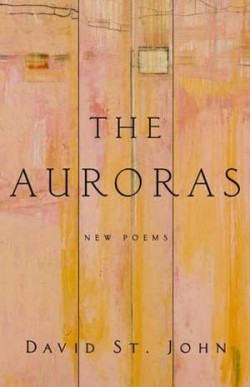 You can see this mastery in his latest collection, The Auroras (Harper Collins, 2012), which he read from that Thursday afternoon in Ithaca, New York. Take “Reckless Wing,” for instance. It begins, though punctuation-less, plainspoken and comprehensible: “The window was open & a horse ran / Along the far edge of our field.” The lines are broken in places that would have a natural pause in a sentence. But later in the poem there are lines like “Formica clearing onto the floor” and “Of toast scarred by yolk newspapers.” The easiest reading of lines like these would be to break them into sentences using the preceding lines so that this section of the poem reads “[You] swept your arm across its yellow Formica, clearing onto the floor coffee cups, plates thatched with rinds of toast scarred by yolk, newspapers, notebooks, & all those distances…” This is, no doubt, how one would read the poem aloud, but looking beyond the syntactical construction is where more interesting meanings begin to emerge. The arm becomes the yellow Formica. The Formica bleeds into the floor. Newspapers are now yolky, nutritious, and on our toast. This absurdity scars the toast. It all becomes weird and muddled, where the body becomes the site of domestication, which is also bombarded with information and technology.
You can see this mastery in his latest collection, The Auroras (Harper Collins, 2012), which he read from that Thursday afternoon in Ithaca, New York. Take “Reckless Wing,” for instance. It begins, though punctuation-less, plainspoken and comprehensible: “The window was open & a horse ran / Along the far edge of our field.” The lines are broken in places that would have a natural pause in a sentence. But later in the poem there are lines like “Formica clearing onto the floor” and “Of toast scarred by yolk newspapers.” The easiest reading of lines like these would be to break them into sentences using the preceding lines so that this section of the poem reads “[You] swept your arm across its yellow Formica, clearing onto the floor coffee cups, plates thatched with rinds of toast scarred by yolk, newspapers, notebooks, & all those distances…” This is, no doubt, how one would read the poem aloud, but looking beyond the syntactical construction is where more interesting meanings begin to emerge. The arm becomes the yellow Formica. The Formica bleeds into the floor. Newspapers are now yolky, nutritious, and on our toast. This absurdity scars the toast. It all becomes weird and muddled, where the body becomes the site of domestication, which is also bombarded with information and technology.
There is also a sense here, that this garbage heap of the domestic life has been there a while, at rest, weighing down the “expanse” between the narrator and the you. Because the poem is so insistently domestic (nothing more domestic than yolk, coffee, and Formica), we automatically assume that this poem is uttered between two partners who have settled in to a long, boring life together. They seem to have a farm (the horse running in the field). If we take the domestic reading (which I don’t necessarily), then the ending (“You raised your eyes to mine to make / Plain another new beginning”) has at least two possibilities. 1) The open wind and running horse, two images heavily coded towards freedom, or a “new beginning,” are made “plain,” quotidian, unexciting, by the context of the you’s outburst at the breakfast table. Odd, but not incomprehensible, because what’s more boring than the little fights we have with our partners at the breakfast table. Just another bit of domestic detritus that will weigh down a long-term commitment. 2) That the you creates a new beginning just by looking. This is accomplished by the line break in the second to last line, where “to make” is left intransitive, a split idiom, lingering on the edge of the action, emphasizing that it’s the verb and its object (“beginning”) that are important here, not necessarily the verbal idiom “make plain.” It could be the destruction of the domestic junk that then connects the characters of the poem to the running horse and open window at the beginning, which is “made plain,” or obvious, as symbols for freedom. And the I and you need only recognize that the symbols they need to start a new, better life are just a ways off, in their field.
The superimposition of the reader onto the you creates another layer of strangeness. We can’t fully escape from the domestic sphere, but at least here, we’ve put ourselves into the you slot, sitting at the table, sweeping our arm across the yellow Formica. But there’s a small grammatical problem with that reading: the antecedent of “its” is actually “arm” (“Swept your arm across its yellow”) which immediately destabilizes us, forcing us into a transforming embodiment of the image-set, a mutable body that turns into metaphor. We still get the transmogrifications of the detritus imagery—the coffee cups and plates become little huts, the toast a victim of media abuse, but we also get the distance (“Notebooks & all of those distances”) between the poet and the reader, and the collections of images that begin at the concrete of the reader’s reality and end in the imagination of the poet. This is the movement of the poem: the things melt into new things, and this garbled collection of hybrid images settles between the place where we imagine ourselves and the place where we imagine these poems taking place. In the penultimate line, however, we turn on the poet, who has thus far controlled the trajectory of the poem. We are the ones who look at the poet, through his poem, to make him. Maybe we’re the ones making obvious a new beginning, or as with the aural pun “plane,” contributing to the making. And plain can also have the meaning of the new beginning: clear, fresh, unmarred, uncreated. In either case, with DSJ, the reader becomes intimately involved in the poems as they are in their narration, but also in the possibility of their creation as we read them. In The Auroras, as always in the work of DSJ, anything can happen.
3.
At the reading in Ithaca, David read some of his more bluesy work, such as “The Aurora of the New Mind,” where he confessed to delighting in the meanness of it. For instance, this poem contains the couplet refrain: “I had been so looking forward to your silence / & what a pity it never arrived.” It’s another poem which actively resists presenting the I and you simply as characters. Instead, the I/you dichotomy becomes a tension between narcissism and desire for others, a tension that is central to DSJ’s poetics. In The Face, a movie was being made about the narrator, artificializing him, making him newly inaccessible, nostalgic, and stuck in a bizarre cinematic sublime. Here in The Auroras, we have the same tensions, but now more resonant with the Romantic sublime, where the architectural beauty of the imagination (“Melodies melodies & the music of my own mind”) is tempered with terror and loss (“Now those alpha waves of desire light up the horizon / Just the way my thoughts all blew wild-empty as you stood / In the doorway to leave in the doorway to leave”). This poem, this book, is a work that both celebrates the realm of the imagination, but also doesn’t trust it in the same way Wallace Stevens does, which is to say fully.
What I mean is that when you get to the final and title section of the book, the one wherein the poet fills his poems with philosophy, the magnetism of mortality finally breaks in at full force. The poems try to resist death with the most startling and excellent images of the book (“[The letter] was ripe / as a planet.”; “When they / found him later, dead, they said how pagan he’d become in his nakedness, // in his glory.”; etc). The book, in fact, ends where all imagination gets sucked back into the flesh whence it came, a form “which is no memory, which is our dark, the form // of dark, & darkness in its final form.” Whoah! That is a hell of a bleak way to end a book. Especially coming from a poet who sat on our stolen couches and drank beer while telling jokes about living in California. But then again, he was dressed in all black.
I refuse to read lines like that as a moment of despair. I go back to the lines that end the incredible “Florentine Aurora”:
…This is my praise; this is my proclamation. This is the apple
I place on the white plate, before you. This is my metaphysics of possibility.
This is the fury of the present. This is the memory of the questions
I offer like pewter goblets. Let us share what remains, while it remains.
It’s all going to end in entropy and decay. We, as poets, get that. But what we should also remember is the “metaphysics of possibility.” That when we write a poem and someone reads it, we have the opportunity to be true magicians, creating something out of nothing. And if not, then we just as soon pass the pewter goblets and enjoy each other while we can.
At the end of the reading, I stood in line to talk to DSJ, hoping he still remembered me and not for anything that was stupid or embarrassing. While readers were getting him to sign their books, a dude walked up to me. For a second, my brain glitched. He said, “Hey Chris, do you remember me?” Before I could think back to how I remembered this person who was obviously not one of my students and wasn’t in my small MFA cohort (basically all the people I knew that could be at the reading), I said, “Evan.” It was Evan Beaty, a poet from San Antonio who shared an apartment with me at Bucknell, and was among the three or four people I felt I got close to during that summer and then subsequently never spoke to again. In about 35 seconds, we began curling over in laughter at seven-year-old jokes and new ones (especially ones made at our own “success” as poets). It was zany and exhilarating. And then we were talking to DSJ about how drunk I was at the final Bucknell party. It was awesome. We all promised to keep in touch. And though we probably won’t, at least not as well as we should, it’s still nice to have that possibility, to pass the goblet, to watch stupid videos, to make fun of ourselves and our maudlin attitudes, because that’s the only way to live, to create, to ward against chaos, to build something out of it.
—Christopher Lirette
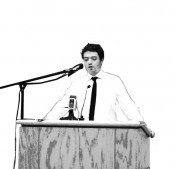 Christopher Lirette, from Chauvin, Louisiana, writes poems and essays about wrestlers, superheroes, and floods. You can find his writing through christopherlirette.com and follow him on twitter under CLImagiste, a nickname from Bucknell.
Christopher Lirette, from Chauvin, Louisiana, writes poems and essays about wrestlers, superheroes, and floods. You can find his writing through christopherlirette.com and follow him on twitter under CLImagiste, a nickname from Bucknell.
June 11, 2012
Contributors’ Marginalia: Brandon Krieg reads Les Murray’s “The Black Beaches”
Though the “The Black Beaches” is a creation myth, its title puts us in mind of the shores of the Styx. But, on the shores of the poem, we encounter no gods, strange dogs, or ferrymen; there is hardly evidence of humans at all. Only in the speaker’s metaphors, many of which compare natural occurrences to human objects or processes, and in the uncanny adjective “knee-sprung” (for pasture that has already, it seems, been walked through or stood up from) do we get a trace of the human.
 It is an elegiac trace—Murray’s metaphors are cannily arcane—towers; dragon-holes; velvet calls to mind a lost medieval nobility; a sugar-lick seems to come from a fading pastoral landscape where horses taste from your hand; even comparing coals to stars can appear obsolescent in a world of light pollution where humans rarely look up. Yet, in a sense, in the span of time Murray’s speaker contemplates (hundreds of millions of years) all human imagination and activity is already obsolescent, already here and gone. In that span, towers and skyscrapers are essentially coincident, equally relevant tropes for forests that burn.
It is an elegiac trace—Murray’s metaphors are cannily arcane—towers; dragon-holes; velvet calls to mind a lost medieval nobility; a sugar-lick seems to come from a fading pastoral landscape where horses taste from your hand; even comparing coals to stars can appear obsolescent in a world of light pollution where humans rarely look up. Yet, in a sense, in the span of time Murray’s speaker contemplates (hundreds of millions of years) all human imagination and activity is already obsolescent, already here and gone. In that span, towers and skyscrapers are essentially coincident, equally relevant tropes for forests that burn.
Time is the only god in the “The Black Beaches,” and its powers of creation are limited by physical laws. Yet its creations are magnificent—it turns mountains into shorelines, forests into peat. What I admire most in this poem is its insistence that the forces of the physical world are adequate sustenance for the imagination, if attended to and contemplated both with and against the grain of prior human knowledge. Murray gracefully combines particular observation, geology, natural history, and myth to bring the strangeness of our condition back to us forcefully. The coal forming all day, the final creation of the poem, is always forming; on a scale of time we can hardly begin to imagine, we, too, are becoming coal, and the black beaches we are going to are far more literal, far less anthropomorphic than we might have imagined, a reversal both terrifying and beautiful.
 Brandon Krieg is a founding editor of The Winter Anthology. Both his poem “Sundress” and Les Murray’s “The Black Beaches” appear in 32 Poems 10.1.
Brandon Krieg is a founding editor of The Winter Anthology. Both his poem “Sundress” and Les Murray’s “The Black Beaches” appear in 32 Poems 10.1.
June 8, 2012
What We’re Reading: Les Murray’s Killing the Black Dog
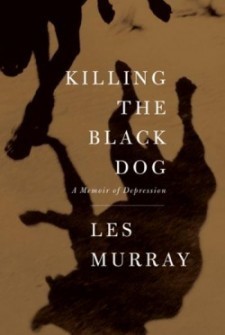 Another poet we’re excited to have in this latest issue of 32 Poems is Les Murray, whose work will be familiar to many of our readers since his career is long and distinguished and he is, in some respects, more popular in the US than in his native Australia. As an admirer of his poems and a lover of prose by poets, I was interested to read his recent memoir and share my thoughts with our blog readers. Like the best prose-stylists, he packs as much into an essay as he does into a poem, and despite the painful content of the narrative, reading this book was a wonderful experience I hope you’ll choose to share.
Another poet we’re excited to have in this latest issue of 32 Poems is Les Murray, whose work will be familiar to many of our readers since his career is long and distinguished and he is, in some respects, more popular in the US than in his native Australia. As an admirer of his poems and a lover of prose by poets, I was interested to read his recent memoir and share my thoughts with our blog readers. Like the best prose-stylists, he packs as much into an essay as he does into a poem, and despite the painful content of the narrative, reading this book was a wonderful experience I hope you’ll choose to share.
Murray’s Killing the Black Dog: a Memoir of Depression (FSG, 2011), is a slender, elegant work of introspection and reflection by a voice that is sharp, unsentimental, and humane. The book continually convinces me of the authenticity of its witness by betraying no motive besides documenting an experience that, having been lived through, demands sharing. Who demands the story’s telling is up for some debate: Murray writes directly to the reader, “You must tell the exact truth, suppressing nothing…I can do this because you aren’t curing me, rather I’m telling you what did help me, and my own part in it.”(Isn’t he also instructing us about writing here? Not just memoir, but poetry?) Of course Murray’s journey is a personal one that we do not take a direct part in, and his pointing this out is consistent with a characteristic frankness. Still, can it be untrue that writing about his illness (or, since the book began as the text of a lecture, speaking about his illness) is a part of his role in the cure, and the reader/listener is essential to complete it? I don’t think (and he never claims) that the book is a purely altruistic enterprise; it’s partly for the writer, even if it’s more for the reader. The reader wants to understand the poet, wants to understand human nature, and often—as in the case of this reader—wants some insight into an illness that he or she has also struggled with: evidence that it can be survived as well as the human intimacy that witness brings, especially when it’s not tarted up as melodrama or used to lionize the author. As we find out in the book’s afterward, Murray’s conviction that he achieved a complete recovery was benighted. In fact he suffered depression at later times and continues to struggle with it as a permanent part of his life, though it is far more manageable and comprehensible now than it was during that long apex.
The first half of Killing the Black Dog is personal essay; the second half is poems, and the two are connected. In fact, as Murray tells the story of his illness, he often refers to specific poems that he wrote in response to stimuli of his life. As a result we’re able to chart the course of the poet’s sickness in the poems. It’s a wonderfully candid move, and, to my mind, argues against those essays of Eliot’s that promote a separation of the poem (an intellectual product) from the personal experience of the poet. It also takes real guts to lay bare the creative work done while suffering mental illness, in part because that work is often of poorer quality than the work done when one is healthy. Murray acknowledges this and openly discusses the difficulty of thinking well, let alone writing. “Mental illness is apt to make you into a bore,” he writes. “I’d always led a crowded mental life, but now my mind became congested, jammed with ideas I couldn’t formulate clearly or nimbly enough, so that they tumbled over each other and made me incoherent.” He also says, “I cut down on writing prose pieces because they were more liable than poetry to be infiltrated with the colours of confusion and obsession…I’d disapproved of using poetry as personal therapy, but the Black Dog taught me better. Get sick enough, and you’ll use any remedy you’ve got.”
Because mental illness is almost always caught up in a dog’s breakfast of misunderstandings and taboos, it’s difficult to talk about. Depression ranges, in common discourse, from a mood to a crippling chronic illness. Even in retrospect, it can be challenging for a depressed person to sort out the origin and quality of each negative feeling. “At first I suffered no more than the normal background depressiveness of a writer,” Murray writes. In expressing the common correlation of creativity and depression (which strikes many artists as verisimilar), he begins to establish the many gradations that depression can have even in one person’s experience. In doing so, he begins to put his finger on the reason clinical depression can be difficult to recognize in oneself. “I suspect that, like very many inherently depressed people, I simply lost the anger contest after babyhood, and learned to secrete my rage deep inside where it would do me maximum harm.” This sentiment must be almost universally relatable, even to people who have never been clinically depressed. Many of Murray’s questions go beyond the problem of living with mental illness to the problem of living in an imperfect world, whether ill or well. “I have always been fascinated by the question of how it is possible, even with the help of deadening stoicism or maniac laughter, to live with the darker aspects of human frightfulness…Introspection showed me that I’d been a sub-clinical depressive for pretty well all my life.”
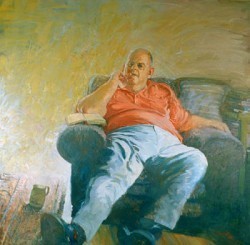
Les Murray, David Naseby, 1995
Murray describes going to the hospital after a panic attack he misidentifies as a heart attack and calls the other patients “truly sick.” This ambivalence about the status of depression as an illness compared to physical illnesses also strikes me as very true. Compared to those in the hospital who were dying, he felt a poseur, but when you consider that he lived for more than twenty years in (at its best) sporadic agony, it seems one could hardly have a more serious illness. In the last sentence of his first paragraph, he writes, “I didn’t know that I was heading home in order to go mad.” Even this, I think, makes an important connection between depression and other forms of mental illness: the disease, while interacting with the events in one’s life, is a biological reality separate from any events that may complicate it.
Murray’s memoir is full of illuminating statements, undressed, simply conveyed, and folded into the story so gently they could be missed. One of them: “We gave each other permission to be ill, a necessary precondition to being cured,” strikes me as almost obvious, but of course it is not. In my experience, an inherent conflict in a depressed person is the struggle to feel, appear, be normal, to be other than what you are, which is sick. This is so entrenched as to be hard to realize, even in retrospect, and it deflects so much of the sick person’s energy into a fruitless cause: pretending to be well never resulted in a cure.
Ultimately, Killing the Black Dog is relevant because its compassion is sincere and directed not only inward, but also towards fellow sufferers of depression, the family who helped to care for him (and were in some cases victims of his illness), and the family of his past who in some ways exacerbated his enduring trauma. Of a friend who committed suicide, Murray writes, “I’ll never blame her, and if you do, you’ve never been where she and I have been and you can’t say anything meaningful to us or about us.” The connection between empathy and the value of what one has to say seems the particular reflection of an artist whose belief it is that good art is an act of communication and communion where, by understanding humanity, one is able to creatively and appropriately engage with it. He repeats this sentiment in a very different context, speaking of his father, who Murray realizes blamed himself for the death of his wife. “If I had not known his shame, I had not known anything.” This idea, that psychological states can be so fundamental to how a person exists in the world that to miss or misunderstand them is to be unable to understand anything about the person, is as much as anything else a reason for introspection, for listening to people and taking pains to imagine their experience and for writing a memoir of this kind and a lifetime’s poems.
—Jasmine V. Bailey
June 4, 2012
Contributors’ Marginalia: Anna M. Evans considers Dan Ferrara’s “Christmas Day, 1776″
My first thought, on reading “Christmas Day, 1776″ in the latest issue of 32 Poems, was that Dan Ferrara must, like me, have some connection to New Jersey, given that our state capital, Trenton, rarely turns up in serious poetry—and a quick look at the contributor’s bios confirmed that he is from Tom’s River. My second thought was to ask myself why more poems like this aren’t being written these days, and by “like this” I don’t mean hauntingly lyrical ballads, although this is a fine example of the form, but poems that emanate either directly or tangentially from famous historical battles.
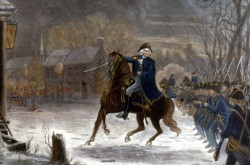
Washington at the Battle of Trenton
Such poems used to be so common they practically formed a genre. I’m thinking of Tennyson’s “Charge of the Light Brigade,” which contributed the phrase “Theirs not to reason why,/Theirs but to do & die” to the English language, or of the aurally rich “Lepanto” by G.K. Chesterton— “From evening isles fantastical rings faint the Spanish gun.” For more contemporary tastes, there is also Robert Lowell’s “For the Union Dead,” which begins and ends in the Boston of his day but has plenty to say in between about Civil War hero Robert Gould Shaw, who fell at the Battle of Fort Wagner.
Like Lowell’s poem, Ferrara’s is not concerned with the actual Battle of Trenton, which took place on December 26th; it is rather an evocation of love and courage in the face of fear felt by one of the young men who was clearly part of the largely untrained militia that comprised the bulk of George Washington’s forces. Probably a smith by trade, the poem’s narrator has just asked his love to marry him:
there molten brass in cuttle mold
sat cooling on my stove
in the shape of the ring I promised you
that night along the cove
But he knows that the day after Christmas he must face an elite force of Hessians, the German mercenaries employed by the English to supplement the redcoats, and he fears the result:
If a Hessian’s axe should cut me down
like a spruce in the frozen bramble
The poem is wistful and poignant, both specific in its detail, and at the same time universal to how all soldiers surely feel on the eve of a battle, particularly against an enemy perceived to be stronger.
And this is where my interaction with the poem becomes more personal. I live near historic Mount Holly, New Jersey, site of the lesser-known Battle of Iron Works Hill, which took place from December 22 to 23, 1776. My battle is actually the reason why the protagonist of Ferrara’s poem need not, in actual fact, have been so fearful about the result of his battle. What happened in Mount Holly was that a raggle-taggle militia—mostly old men and boys—of 600 put on a display of resistance that lured 2000 Hessians, under the command of Count Carl von Donop, south from their Bordentown garrison.
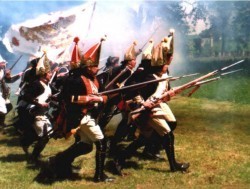
Hessians
The colonials were eventually routed, and the Hessians settled into Mount Holly for Christmas, rounding up all the alcohol in the town and proceeding to get drunk. They were therefore too far from Trenton, and at any rate, in no fit condition, to be of use in the Battle of Trenton, which Washington duly won with very few American casualties. I hope Ferrara’s young blacksmith wasn’t one of them.
Thus “Christmas Day, 1776″ evoked a reaction from me on three levels—it prompted me firstly, at an academic level, to revisit this whole idea of the genre of battle poems; secondly, on an emotional level, to admire the skill with which Ferrara handles the young man’s feelings; and finally, on a personal level, to want to write a ballad in response from the point of view of one of the young Mount Holly boys.
There is no way one can possibly ask more from reading a new poem than all of that!
—Anna M. Evans
 Anna M. Evans is the editor of Raintown Review and currently teaches poetry at West Windsor Art Center. Her chapbooks, Swimming and Selected Sonnets, are available from Maverick Duck Press.
Anna M. Evans is the editor of Raintown Review and currently teaches poetry at West Windsor Art Center. Her chapbooks, Swimming and Selected Sonnets, are available from Maverick Duck Press.
June 3, 2012
Introducing “Contributors’ Marginalia”
When Deborah Ager and John Poch founded 32 Poems a decade ago, they did so largely because they felt significant poems were being neglected. It was clear to them (from their previous editorial experience and from their time teaching and participating in workshops) that exciting work was going unpublished, read only by the lucky few who saw those poems in manuscript. In addition to offering such work a print home specifically designed for intimate and uncluttered reading, they also committed themselves to championing their poets and poems after publication, in the space between journal and book where so many valuable poems are forgotten. The record of 32 Poems reprints in such series as Best American Poetry and Best New Poets and on such “best of” sites as Verse Daily and Poetry Daily is a testament to their efforts, as is the 32 Poems anthology, Old Flame, forthcoming from WordFarm this summer.

It was also that special perspective on an editor’s role and responsibilities that attracted the current editorial team to the journal. In recent months we have returned to the notion that a poem’s publication should not begin its disappearance and we have asked ourselves what else we can do to draw more attention to the work that has excited us.
When the new issue went out a few weeks ago, we asked the poets of 32 Poems 10.1 to engage with the work of their fellow contributors by selecting a poem to examine in terms of craft and aesthetic, by considering how it dialogues with their own work, or by simply dramatizing the experience of reading a poem that thrills them. In effect, we’d like to host a conversation that ranges from poem to poem, poet to poet, a discussion that allows us to read the issue alongside one another and to revisit the work through the lens of another writer.
We’ve been thrilled by our contributors’ enthusiasm for this project, and beginning tomorrow, we’ll be sharing their responses here on the 32 Poems blog in a weekly feature that we are calling “Contributors’ Marginalia.” While our poets will be initiating these meditations, it is our hope that the exchange will expand to include the larger community of 32 Poems readers and friends. Ultimately we want to invite each of you to think through these poems with us and to join us in celebrating the lasting pleasures of their language.
—George David Clark



